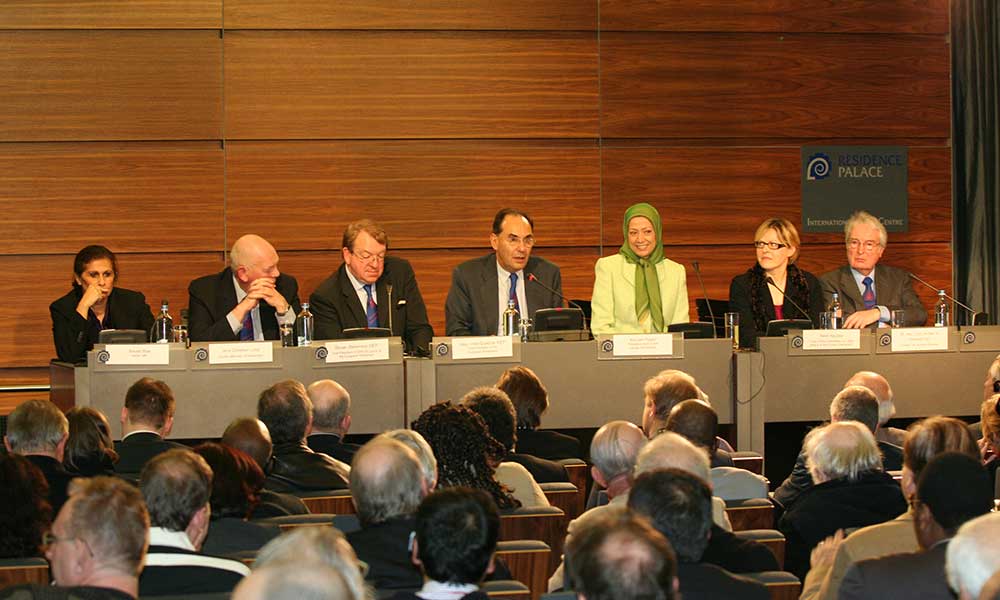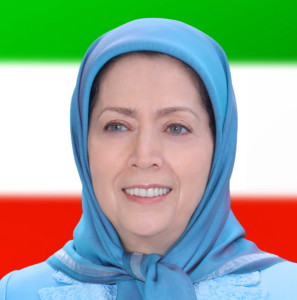Maryam Rajavi: IRGC takes over regime’s intelligence apparatus

The million-strong uprising on November 4 in Tehran and 20 other major cities across Iran signaled the advancement of the Iranian people’s struggle to overthrow the clerical regime. The significance of this development can be better appreciated if we consider it from several different respects.
The diversity of the participants showed that despite the brutal suppression, a vast number of people in Iran from various social backgrounds and demographics have joined the struggle.
More importantly, the slogans which targeted Khamenei directly, and protest acts like trampling over his portraits on Iran’s streets, all demonstrated the Iranian people’s pressing desire to overthrow the regime in its entirety.
Video clips of scenes of protests also indicate that the Iranian society strongly criticizes Mr. Obama’s soft stance vis-à-vis the mullahs’ dictatorship.
Another very important aspect was the active participation of women, who in some cases took charge of the leadership of the demonstrations.
To overcome such a crisis, Khamenei has intensified suppression inside the country and the confrontation against the organized opposition on the one hand, and on the other hand he is striving to acquire nuclear weapons and has resorted to meddling in the affairs of other countries in the region and exporting of terrorism.
Today, I would like to draw your attention to the mullahs’ behind the scenes decisions on two central issues; One concerns the creation of a centralized organization for repression and terror, and the other is to accelerate the production of a nuclear bomb.
Although the mullahs have made public declarations about the new organization, they have nonetheless concealed its real dimensions and true nature. This new organization is called the Intelligence Organization of the Islamic Revolutionary Guard Corps and will from this point onwards act as the regime’s main security force. Its command structure is linked directly to Khamenei, the regime’s Supreme Leader. Its formation marks an unprecedented transformation for the regime’s intelligence and suppressive apparatus.
Regarding the regime’s nuclear project, I will outline the mullahs’ secret roadmap for producing a nuclear weapon. The public face of this policy seeks to maintain negotiations with the P5+1. But behind the scenes, this policy is meant to facilitate ceaseless progress towards uranium enrichment above the 90 percent threshold as well as the production of nuclear warheads and ballistic missiles.
The mullahs’ policy of domestic suppression and their insistence on continuing the nuclear project are two sides of the same coin.
The aim of centralizing the suppressive forces is to curb the Iranian people’s uprising, and the objective of seeking nuclear weapons by any means necessary, is to restore a balance of power that has been upset for the regime.
Reports from inside the regime indicate that the anxiety about the threat posed by this uprising was so profound that the regime tasked its highest commander, that of the IRGC, Mohammad-Ali Jafari, to oversee the suppressive operations against the protests on November 4.
On November 3, Brig. Gen. Jafari met with all IRGC commanders in Tehran.
He declared that the Guards have an open hand (i.e. no restrictions) for attacking protestors.
The IRGC commanders were worried that the uprising might lead to the fall of the main centers of power in Tehran. Therefore, a number of battalions were sent to protect Khamenei’s residence. Despite all these measures the regime has failed to contain the uprising.
The serious changes in the IRGC and the intelligence and security apparatus introduced by Khamenei, and brought about by the formation of the IRGC Intelligence Organization, are meant to deal with these circumstances.
In October, the IRGC Commander, Jafari, announced that the Directorate of Intelligence at the IRGC has been elevated to an organization headed by Hossein Taeb. Reports obtained from inside the regime indicate that this was an important change to shield the regime against the uprisings.
According to the same reports, so far seven major forces have been merged into this new organization, and they include:
First, the Sarollah Headquarters, which is the main center for directing suppressive operations in Tehran, and commands all police, IRGC, and paramilitary units;
Second, the IRGC Directorate of Intelligence, consisting of units for pursuit and surveillance;
Third, some sections of the Internal Security Directorate at the Ministry of Intelligence and Security;
Fourth, the Security Directorate of the paramilitary Bassij Force of the IRGC, which consists of espionage networks embedded in all parts of society;
Fifth, Khamenei’s special intelligence office called Department 101;
Sixth, plainclothes agents, special forces for the suppression of street protests;
And, seventh, the Control Center for Internet Activities.
This organization is headquartered in Ghasreh Firouzeh (Firouzeh Palace) district, where the IRGC has its command center, in a township called Kamali, which only a few people know about.
Allow me to point out the goal and nature of this new organization:
The objective is to centralize the intelligence and security organs, in a way that makes this new organization dominant and the Ministry of Intelligence and Security (MOIS) subservient to it in matters of security. With regards to its command structure, this new organization will be directly controlled by Khamenei and his special secretary, Mullah Hejazi. In this respect, it will not even be dependent on the president or Majlis (Parliament).
Hossein Taeb, who Khamenei has appointed to head the organization, is a close friend of Khamenei’s son, Mojtaba.
In terms of the nature of its role, the new organization has a security-intelligence mandate on the one hand, and a military and operational nature on the other, which provides it with covert and paramilitary arms.
These changes take place in the context of a weakened and crisis-ridden regime. They will therefore be accompanied by severe tensions. In particular, the regime has launched a secret purge within the Intelligence Ministry, which grips hundreds of intelligence directors and veteran agents. Therefore, these changes will render the regime even more militarized under Khamenei’s hegemony.
The next topic concerns the regime’s roadmap to obtain a nuclear weapon. Together with merging suppressive forces, this policy is yet another effort by a crisis-ridden regime to prevent its downfall.
The measure has been adopted by the regime’s Supreme National Security Council (SNSC) and approved by Khamenei.
It concentrates on the following major points:
1. The regime will not stop negotiations with the P5+1 because according to Khamenei’s directives, negotiations allow for gradual progress in the production of a nuclear weapon.
2. Khamenei has emphasized that prolonging negotiations would be beneficial because it would both prevent the United States from supporting the popular uprising and also create rifts within the international community when it comes to the imposition of sanctions.
3. Not only will the regime’s stockpile of enriched uranium not be sent to Russia or any other country, it will continue to increase.
4. As an initial objective, the regime intends to start enriching uranium up to 20 percent inside Iran. The regime’s demand to buy 20 percent enriched uranium from other countries is in actuality a pretext to increase the level of its own enrichment inside Iran. The goal of the regime is to reach 90 percent enrichment which is required for producing a nuclear weapon.
5. The regime is also stepping up its efforts to manufacture nuclear warheads. The manufacturing of warheads has been carried out in the context of the P111 project. Currently, new plans are under way at the Aerospace Industries Organisation at the Khojir region.
I would also like to point out yet another aspect of the regime’s efforts to confront the domestic uprisings and the Iranian people’s resistance. That is, the mullahs’ attack and incessant plots against Ashraf in Iraq, which is home to 3,400 members of the People’s Mojahedin Organization of Iran (PMOI/MEK).
The clerical regime’s Supreme Leader, Khamenei, has concluded that the necessary condition for closing the rift within his regime as well as for containing the uprisings is to suppress Ashraf. In February, when he was planning to carry out purges within his regime and preparing to secure Ahmadinejad’s second term as president, Khamenei announced a bilateral agreement between his regime and Iraq to expel the PMOI.
On July 28, when he sought to suppress the domestic uprising, he coordinated the attack on Ashraf. The attack, of course, was defeated. Even so, plots against Ashraf continue. The mullahs and their proxies in Iraq seek to forcibly displace the residents of Ashraf and to murder and suppress them on a larger scale.
Therefore, I call on the United States, the European Union and the United Nations to provide sufficient guarantees to protect Ashraf residents against a repeat of the killings, violence and forced displacement.
Ladies and Gentlemen,
The present critical situation along with the regime’s instability give rise to the question: Where will all this lead to?
As Khamenei recently emphasized, when it comes to the nuclear program, he will neither retreat nor show any signs of flexibility.
Moreover, the regime’s tensions with the West will rise. The regime will continue to close its ranks and step up terrorism and meddling in other countries of the region.
Despite all this, the Iranian people’s uprisings for freedom will persist as the process of regime change advances.
In such circumstances, the European Union has a special role to play. Today, the EU has made a great leap and is about to elect a president and a foreign minister. This milestone event will definitely strengthen the EU’s political status.
As a result of this, when it comes to the immediate global issues and most important of them all, the threats posed by the Iranian regime and its nuclear program for the entire world, the EU shoulders a much greater responsibility.
This issue has gained even greater significance since the largest EU member states have confirmed the military nature of the regime’s nuclear activities, and now that the regime’s missiles can target Europe.
It is my hope that the EU will take a firm position vis-à-vis the Iranian regime and support the Iranian people’s uprising and resistance.
I thank you all.

